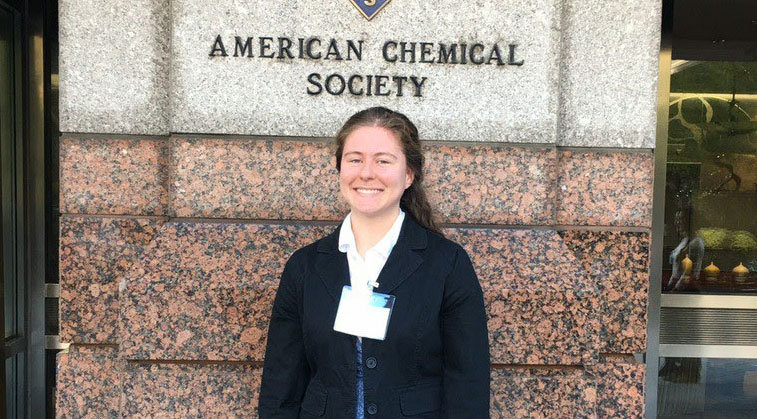Page 16 • (1,300 results in 0.022 seconds)
-
help with hand-eye coordination and/or dexterity.Chemistry Courses Take the following two course sequence in General Chemistry: CHEM 115 (General Chemistry I) CHEM 116 (General Chemistry II) Take the following two course sequence in Organic Chemistry: CHEM 331/333 (Organic Chemistry I + laboratory) CHEM 332/334 or 346 (Organic Chemistry II + laboratory) Some dental schools require one semester of biochemistry. Please make sure you look at the requirements of individual schools.English/Public
-
help with hand-eye coordination and/or dexterity.Chemistry Courses Take the following two course sequence in General Chemistry: CHEM 115 (General Chemistry I) CHEM 116 (General Chemistry II) Take the following two course sequence in Organic Chemistry: CHEM 331/333 (Organic Chemistry I + laboratory) CHEM 332/334 or 346 (Organic Chemistry II + laboratory) Some dental schools require one semester of biochemistry. Please make sure you look at the requirements of individual schools.English/Public
-
for positions: https://ecology.wa.gov/About-us/Get-to-know-us/News/2018/July-3-300-WCC-positions-now-open You can learn more about individual placement positions here: https://ecology.wa.gov/About-us/Our-role-in-the-community/Washington-Conservation-Corps/WCC-Individual-Placement-Program Chemistry alum Alice Henderson reported a really positive experience in her IP position through the Washington Conservation Corps. Read Previous Summer Sessions: General and Organic Chemistry at PLU Read Next
-
intended to demonstrate competency in grammar and composition as well as comprehension and analysis of written work. In general, the English requirement is met by taking courses that medical schools would recognize as writing or literature courses. Chemistry Courses Take the following two-course sequence in general chemistry: CHEM 115 (General Chemistry I)* CHEM 116 (General Chemistry II) Take the following two-course sequence in organic chemistry: CHEM 331/333 (Organic Chemistry I + laboratory) CHEM
-
intended to demonstrate competency in grammar and composition as well as comprehension and analysis of written work. In general, the English requirement is met by taking courses that medical schools would recognize as writing or literature courses. Chemistry Courses Take the following two-course sequence in general chemistry: CHEM 115 (General Chemistry I)* CHEM 116 (General Chemistry II) Take the following two-course sequence in organic chemistry: CHEM 331/333 (Organic Chemistry I + laboratory) CHEM
-
courses in the subject area, please check with your chosen school to make sure you fulfill this requirement. We recommend you take the following courses: PSYC 101: Introduction to Psychology SOCI 101: Introduction to Sociology Chemistry Courses Take the following two-course sequence in general chemistry: CHEM 115: General Chemistry I* CHEM 116: General Chemistry II You might also consider taking a semester of organic chemistry: CHEM 331/333: Organic Chemistry I + lab *Note: Math 140 is a prerequisite
-
courses in the subject area, please check with your chosen school to make sure you fulfill this requirement. We recommend you take the following courses: PSYC 101: Introduction to Psychology SOCI 101: Introduction to Sociology Chemistry Courses Take the following two-course sequence in general chemistry: CHEM 115: General Chemistry I* CHEM 116: General Chemistry II You might also consider taking a semester of organic chemistry: CHEM 331/333: Organic Chemistry I + lab *Note: Math 140 is a prerequisite
-

Aminda Cheney-Irgens ’20 on her chemistry and Hispanic studies double major, research in Puerto Rico, and preparing for graduate school Posted by: Marcom Web Team / May 20, 2020 Image: Aminda Cheney-Irgens ’20 visits the American Chemical Society. May 20, 2020 By Lisa Patterson '98Marketing & Communications Guest WriterAminda Cheney-Irgens is a smart, driven, and globally-minded Pacific Lutheran University senior who, like her peers, spent her spring adjusting to a new way of doing college
-
designates an appropriate time(s) in which to take the examination. The current format of the PCAT includes the following sections: Writing – conventions of language and problem solving. Verbal Ability – analogies and sentence completion. Biology – general biology, microbiology, human anatomy and physiology. Chemistry – general chemistry, organic chemistry and basic biochemical processes. Reading Comprehension – comprehension, analysis and evaluation. Quantitative Ability – basic math, algebra
-
designates an appropriate time(s) in which to take the examination. The current format of the PCAT includes the following sections: Writing – conventions of language and problem solving. Verbal Ability – analogies and sentence completion. Biology – general biology, microbiology, human anatomy and physiology. Chemistry – general chemistry, organic chemistry and basic biochemical processes. Reading Comprehension – comprehension, analysis and evaluation. Quantitative Ability – basic math, algebra
Do you have any feedback for us? If so, feel free to use our Feedback Form.


